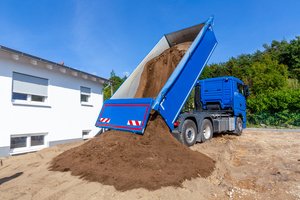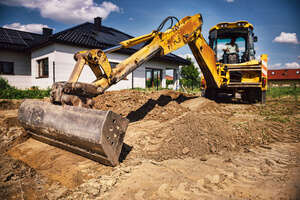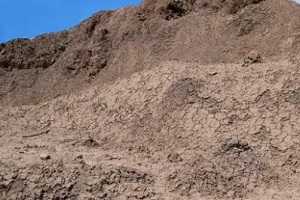Soil, often overlooked but undeniably essential, is the foundation for many of our endeavors. Whether you’re nurturing a vibrant garden, embarking on a landscaping project, or constructing a sturdy building, the type of soil you choose can make or break your success. In the world of soil, two main contenders take center stage: topsoil and fill dirt.
In this blog, we’ll dig deep into these soil types, exploring their differences, applications, and how to make the right choice for your project.
Understanding Topsoil
Topsoil, the uppermost layer of soil, typically resides within the top 2 to 12 inches of the Earth’s surface. What sets it apart is its richness in organic matter and essential nutrients, making it the go-to choice for gardening and landscaping enthusiasts.
This organic goldmine is teeming with life, hosting microorganisms and vital nutrients like nitrogen and phosphorus. These elements together create the perfect environment for plant roots to thrive, drawing sustenance and moisture from the nutrient-rich topsoil.
As plants anchor themselves securely, the result is robust growth and the foundation for lush, vibrant landscapes. Identifying quality topsoil is a straightforward process – it should be dark, crumbly, and free of debris. A quick “ribbon test,” performed by squeezing a handful of topsoil, can help assess its texture and moisture content, ensuring it meets the standards necessary for your green endeavors.
Exploring Fill Dirt
In stark contrast to the nutrient-rich topsoil, fill dirt constitutes a different breed of soil. It is primarily composed of subsoil or other natural earth materials, presenting a stark difference in composition when compared to topsoil. This distinction lies at the core of its functional role in various projects.
Fill dirt is the unheralded workhorse of the construction world. It thrives in its practicality, finding its place in a multitude of applications. It is the go-to material for filling holes, whether they’re small voids or large excavations. Its ability to create level bases for structures and provide the foundational support needed for everything from residential homes to towering skyscrapers is where fill dirt truly shines.
Topsoil Vs. Fill Dirt

The differences between fill dirt and topsoil extend beyond their composition to encompass texture and nutrient content. Fill dirt is denser, with fewer organic materials. This density makes it ill-suited for planting or nurturing vegetation, as it lacks the essential nutrients and microbial life that topsoil boasts. However, this inherent density is what makes it invaluable for its structural role, offering stability and load-bearing capacity where needed.
When it comes to selecting the right fill dirt for specific projects, it’s crucial to consider a range of factors. These include compaction properties, drainage capabilities, and the precise requirements of the project at hand. The choice of fill dirt can significantly impact the structural integrity and longevity of construction and grading projects, making it vital to choose wisely based on the unique demands of each endeavor.
Key Differences Between Topsoil and Fill Dirt
Topsoil and fill dirt exhibit distinct differences in their texture, composition, and suitability for various applications. Topsoil is characterized by its loose, crumbly nature and its richness in nutrients, making it an ideal choice for gardening and landscaping projects. It contains high levels of organic matter, which are essential for promoting healthy plant growth.
On the other hand, fill dirt is denser and less fertile, lacking the nutrient-rich characteristics of topsoil. Fill dirt finds its strength in construction and grading tasks, where its compactness and stability are advantageous.
When considering cost, it’s important to note that topsoil is generally pricier than fill dirt due to its superior composition and nutrient content. Therefore, the choice between these two types of soil depends on the specific requirements of your project and your budget constraints.
When to Use Topsoil or Fill Dirt
Deciding whether to use topsoil or fill dirt depends on the specific scenarios and project requirements at hand. When it comes to gardening and landscaping endeavors, topsoil takes center stage. It becomes indispensable for those aiming to cultivate lush gardens, maintain green lawns, or create vibrant and thriving landscapes. The loose, nutrient-rich nature of topsoil provides an ideal environment for healthy plant growth, making it a top choice for such projects.
Conversely, in construction and grading situations, fill dirt is the preferred choice. Fill dirt serves as the foundation for erecting sturdy buildings, achieving level surfaces, and ensuring the stability of various construction projects. Its denser and less fertile composition lends itself well to creating solid bases and addressing grading needs.
Ultimately, the decision between topsoil and fill dirt often boils down to a delicate balance between cost-effectiveness and project requirements. Evaluating the goals and budget constraints of your project is crucial in making the right choice between these two types of soil to ensure the successful completion of your endeavor.
Quality Assessment and Testing
Soil testing plays a pivotal role in any project involving the application of topsoil or fill dirt, serving as a critical step to ensure that the chosen soil type aligns with the specific requirements of your endeavor. To begin with, it’s essential to conduct soil tests, as they provide valuable insights into the quality and suitability of the soil for your project.
Various common tests are employed to assess soil quality, including standard assessments that measure key factors such as pH levels, nutrient content, and compaction characteristics. These tests serve as quantitative indicators of the soil’s properties and are instrumental in determining its overall fitness for the intended purpose.
Once the soil tests are completed, the next crucial step involves interpreting the results. Properly understanding and analyzing the data obtained from these tests will provide you with the knowledge needed to make informed choices regarding the selection of topsoil or fill dirt for your project. This interpretive process ensures that you choose the most suitable soil type based on the specific requirements of your project, ultimately contributing to its success and effectiveness.
Environmental Considerations

Environmental considerations are paramount when it comes to the use of soil, whether it be topsoil or fill dirt. Both types have their associated environmental impacts, underscoring the importance of responsible usage to minimize adverse effects on the ecosystem.
Mitigating these environmental impacts when using topsoil and fill dirt involves adopting sustainable practices. Among these practices, reusing soil and minimizing waste stand out as effective measures. By reusing soil, you can not only reduce the volume of soil needed for new projects but also lower the overall environmental consequences associated with excessive soil extraction and disposal.
Recycling and reusing soil in eco-friendly ways represent a key strategy in this regard. For instance, considering the recycling of soil from excavation projects can not only contribute to a reduction in waste but also lead to cost savings. These sustainable approaches align with responsible soil management practices, which are essential for preserving the environment while meeting project requirements.
Reach Out to Topsoil and Fill Dirt Experts
As we’ve unearthed the distinctions between topsoil and fill dirt, it becomes clear that choosing the right soil for your project is paramount. Topsoil and fill dirt each have their unique roles and advantages, and understanding these differences will pave the way for success.
Whether you’re cultivating a flourishing garden or constructing a solid foundation, soil matters. Get in touch with Dirt Connections today for high-quality topsoil and fill dirt in the Northern Virginia area.










































